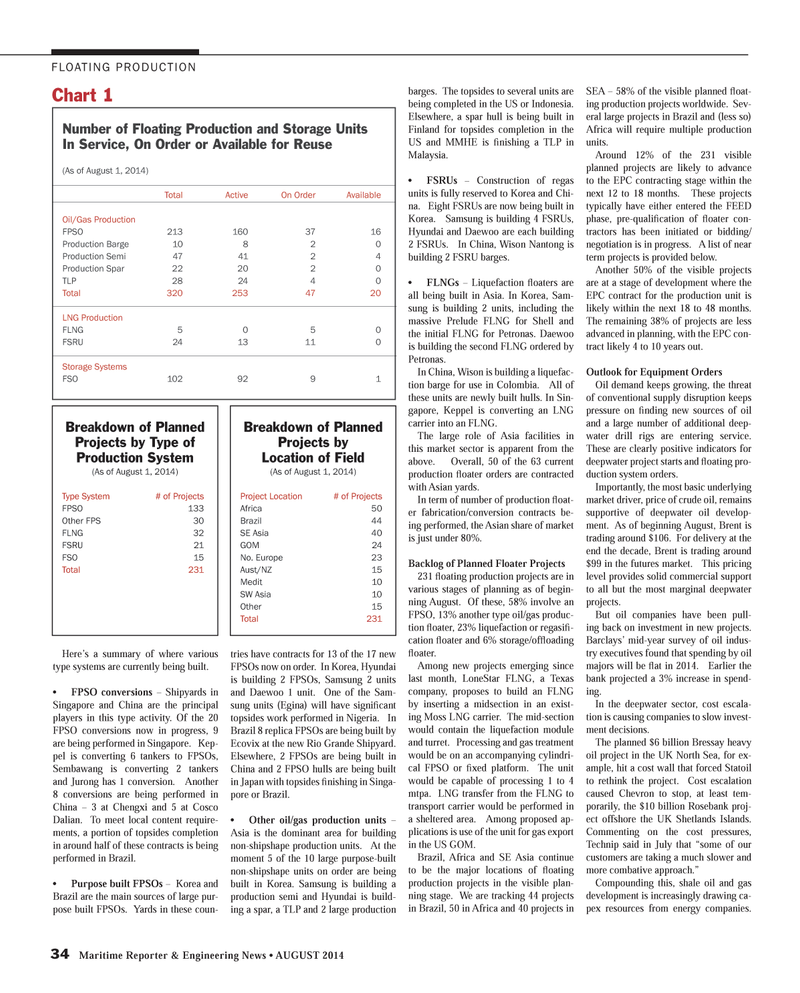
Page 34: of Maritime Reporter Magazine (August 2014)
Shipyard Edition
Read this page in Pdf, Flash or Html5 edition of August 2014 Maritime Reporter Magazine
34 Maritime Reporter & Engineering News ? AUGUST 2014 Here?s a summary of where various type systems are currently being built.? FPSO conversions ? Shipyards in Singapore and China are the principal players in this type activity. Of the 20 FPSO conversions now in progress, 9 are being performed in Singapore. Kep-pel is converting 6 tankers to FPSOs, Sembawang is converting 2 tankers and Jurong has 1 conversion. Another 8 conversions are being performed in China ? 3 at Chengxi and 5 at Cosco Dalian. To meet local content require- ments, a portion of topsides completion in around half of these contracts is being performed in Brazil.? Purpose built FPSOs ? Korea and Brazil are the main sources of large pur- pose built FPSOs. Yards in these coun- tries have contracts for 13 of the 17 new FPSOs now on order. In Korea, Hyundai is building 2 FPSOs, Samsung 2 units and Daewoo 1 unit. One of the Sam-sung units (Egina) will have signiÞ cant topsides work performed in Nigeria. In Brazil 8 replica FPSOs are being built by Ecovix at the new Rio Grande Shipyard. Elsewhere, 2 FPSOs are being built in China and 2 FPSO hulls are being built in Japan with topsides Þ nishing in Singa- pore or Brazil.? Other oil/gas production units ? Asia is the dominant area for building non-shipshape production units. At the moment 5 of the 10 large purpose-built non-shipshape units on order are being built in Korea. Samsung is building a production semi and Hyundai is build-ing a spar, a TLP and 2 large production barges. The topsides to several units are being completed in the US or Indonesia. Elsewhere, a spar hull is being built in Finland for topsides completion in the US and MMHE is Þ nishing a TLP in Malaysia. ? FSRUs ? Construction of regas units is fully reserved to Korea and Chi-na. Eight FSRUs are now being built in Korea. Samsung is building 4 FSRUs, Hyundai and Daewoo are each building 2 FSRUs. In China, Wison Nantong is building 2 FSRU barges. ? FLNGs ? Liquefaction ß oaters are all being built in Asia. In Korea, Sam- sung is building 2 units, including the massive Prelude FLNG for Shell and the initial FLNG for Petronas. Daewoo is building the second FLNG ordered by Petronas. In China, Wison is building a liquefac- tion barge for use in Colombia. All of these units are newly built hulls. In Sin-gapore, Keppel is converting an LNG carrier into an FLNG.The large role of Asia facilities in this market sector is apparent from the above. Overall, 50 of the 63 current production ß oater orders are contracted with Asian yards. In term of number of production ß oat-er fabrication/conversion contracts be-ing performed, the Asian share of market is just under 80%. Backlog of Planned Floater Projects 231 ß oating production projects are in various stages of planning as of begin-ning August. Of these, 58% involve an FPSO, 13% another type oil/gas produc-tion ß oater, 23% liquefaction or regasi Þ -cation ß oater and 6% storage/of ß oading ß oater. Among new projects emerging since last month, LoneStar FLNG, a Texas company, proposes to build an FLNG by inserting a midsection in an exist-ing Moss LNG carrier. The mid-section would contain the liquefaction module and turret. Processing and gas treatment would be on an accompanying cylindri-cal FPSO or Þ xed platform. The unit would be capable of processing 1 to 4 mtpa. LNG transfer from the FLNG to transport carrier would be performed in a sheltered area. Among proposed ap- plications is use of the unit for gas export in the US GOM.Brazil, Africa and SE Asia continue to be the major locations of ß oating production projects in the visible plan-ning stage. We are tracking 44 projects in Brazil, 50 in Africa and 40 projects in SEA ? 58% of the visible planned ß oat-ing production projects worldwide. Sev-eral large projects in Brazil and (less so) Africa will require multiple production units.Around 12% of the 231 visible planned projects are likely to advance to the EPC contracting stage within the next 12 to 18 months. These projects typically have either entered the FEED phase, pre-qualiÞ cation of ß oater con- tractors has been initiated or bidding/negotiation is in progress. A list of near term projects is provided below. Another 50% of the visible projects are at a stage of development where the EPC contract for the production unit is likely within the next 18 to 48 months. The remaining 38% of projects are less advanced in planning, with the EPC con-tract likely 4 to 10 years out.Outlook for Equipment Orders Oil demand keeps growing, the threat of conventional supply disruption keeps pressure on Þ nding new sources of oil and a large number of additional deep- water drill rigs are entering service. These are clearly positive indicators for deepwater project starts and ß oating pro- duction system orders.Importantly, the most basic underlying market driver, price of crude oil, remains supportive of deepwater oil develop-ment. As of beginning August, Brent is trading around $106. For delivery at the end the decade, Brent is trading around $99 in the futures market. This pricing level provides solid commercial support to all but the most marginal deepwater projects. But oil companies have been pull-ing back on investment in new projects. Barclays? mid-year survey of oil indus- try executives found that spending by oil majors will be ß at in 2014. Earlier the bank projected a 3% increase in spend-ing. In the deepwater sector, cost escala- tion is causing companies to slow invest-ment decisions. The planned $6 billion Bressay heavy oil project in the UK North Sea, for ex-ample, hit a cost wall that forced Statoil to rethink the project. Cost escalation caused Chevron to stop, at least tem-porarily, the $10 billion Rosebank proj-ect offshore the UK Shetlands Islands. Commenting on the cost pressures, Technip said in July that ?some of our customers are taking a much slower and more combative approach.? Compounding this, shale oil and gas development is increasingly drawing ca-pex resources from energy companies. FLOATING PRODUCTION Breakdown of Planned Projects by Location of Field(As of August 1, 2014) Project Location # of Projects Africa 50Brazil 44SE Asia 40GOM 24 No. Europe 23Aust/NZ 15 Medit 10 SW Asia 10 Other 15 Total 231 Breakdown of Planned Projects by Type of Production System (As of August 1, 2014) Type System # of Projects FPSO 133 Other FPS 30FLNG 32FSRU 21 FSO 15 Total 231 Number of Floating Production and Storage Units In Service, On Order or Available for Reuse (As of August 1, 2014) Total Active On Order Available Oil/Gas Production FPSO 213 160 37 16 Production Barge 10 8 2 0 Production Semi 47 41 2 4Production Spar 22 20 2 0TLP 28 24 4 0 Total 320 253 47 20 LNG Production FLNG 5 0 5 0 FSRU 24 13 11 0 Storage Systems FSO 102 92 9 1 Chart 1MR #8 (34-41).indd 34MR #8 (34-41).indd 348/4/2014 11:16:45 AM8/4/2014 11:16:45 AM

 33
33

 35
35
